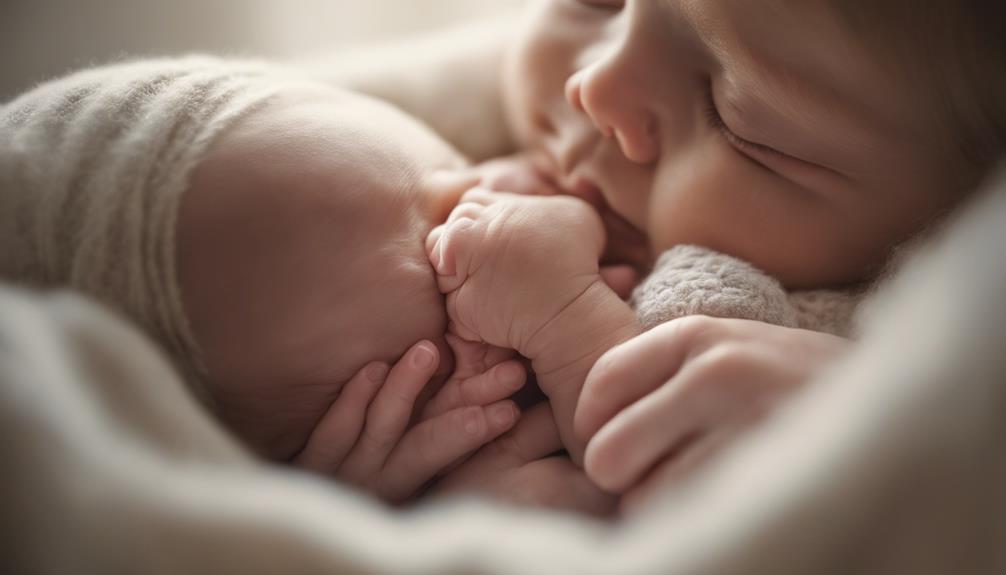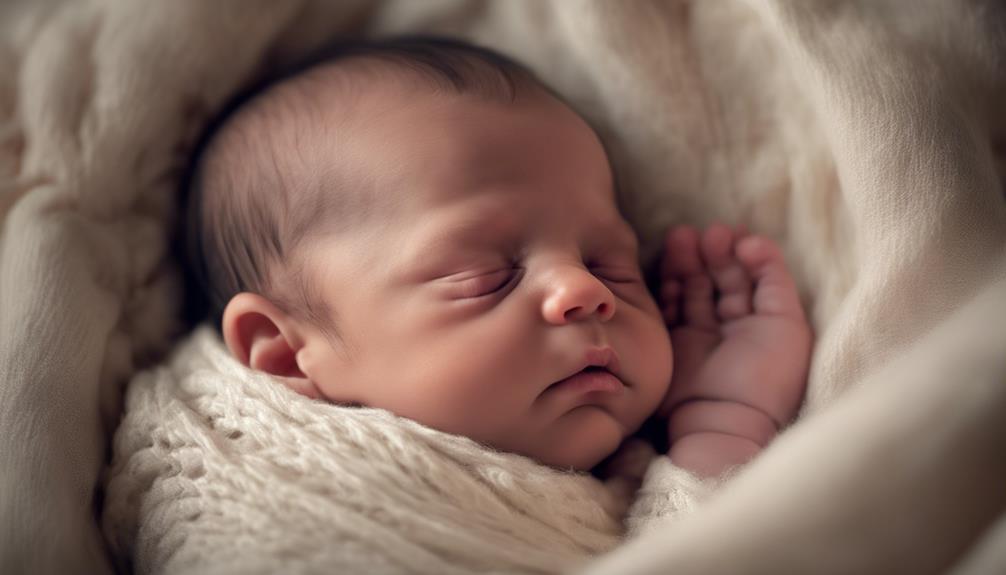As parents, we all face the challenge of figuring out why our newborns seem to only find comfort in sleeping in our arms.
The journey of understanding their sleep preferences can be filled with uncertainties and exhaustion, but there are underlying reasons that shed light on this behavior.
Exploring the science behind this phenomenon can provide valuable insights that may offer solutions to help both baby and caregiver find restful nights.
Key Takeaways
- Understand the reasons behind arm-sleeping behavior for warmth and security.
- Balance the benefits of arm sleeping with the need for independent sleep habits.
- Gradually transition your baby to independent sleep through consistency and routine.
- Overcome arm-sleeping challenges by establishing a bedtime routine and promoting self-soothing.
Reasons Behind Arm-Sleeping Behavior
Understanding why newborns exhibit arm-sleeping behavior is essential for caregivers to provide the best support for their little ones' sleep needs.
Babies, accustomed to the warmth and swaying movements of the womb, find comfort and security in being cradled in arms. This closeness replicates the fourth trimester's need for constant contact, soothing babies and promoting sleep. Holding a baby not only regulates their body temperature but also offers a sense of familiarity that eases them into slumber.
The calming reflex, developed from the soothing sensations in the womb, further reinforces the preference for arm-sleeping. Sudden changes in the sleep environment can startle babies awake, making them seek the soothing reassurance of being held during sleep.
Impact of Supported Sleep Habits

Supported sleep habits play an important role in shaping a newborn's ability to self-soothe and develop independent sleep patterns. While holding your baby for sleep can provide a sense of security, it is crucial to think about the long-term impacts on their sleep habits. Consistently being held for naps and bedtime may create a dependency that makes it challenging for babies to shift to sleeping independently. This reliance on being held can disrupt their natural sleep cycle, leading to frequent night awakenings. Establishing a consistent sleep routine is vital for helping babies learn to self-soothe and develop healthy sleep habits. Gradually reducing the need for being held during sleep can support their shift to independent sleep and promote better overall rest. Let's take a closer look at how different sleep habits can influence your baby's ability to self-soothe and sleep independently:
| Impact of Supported Sleep Habits | ||
|---|---|---|
| Can lead to dependency | Disrupts sleep cycle | Difficulty shifting to independent sleep |
| May cause night awakenings | Supports self-soothing | Promotes healthy sleep habits |
Pros and Cons of Arm Sleeping

As we consider the impact of supported sleep habits on newborns, it's important to weigh the pros and cons of arm sleeping as a comforting practice for infants. When a baby falls asleep in your arms, it can provide a sense of comfort, warmth, and security, replicating the closeness of the womb environment. This closeness and constant movement often soothe newborns, making it easier for them to drift off to sleep.
However, there's a downside to this cozy arrangement. Over-reliance on arm sleeping may hinder the development of independent sleep skills in newborns. If babies become accustomed to sleeping in your arms, they may struggle to shift to sleeping independently.
Consistency and gradual steps are vital in helping babies learn to sleep on their own without always needing to be held. Balancing the benefits of arm sleeping with the importance of fostering independent sleep skills is vital for a healthy sleep routine for your newborn.
Transitioning to Independent Sleep

To help your newborn shift to independent sleep, we recommend starting with patience, consistency, and a gradual approach. Begin by practicing independent sleep during one nap a day in the crib while your baby is drowsy but awake. This allows them to start associating the crib with sleep.
As your baby gets used to this, try laying them down awake at bedtime to encourage self-soothing. Adjust the order of naptime events to establish a routine that promotes independent sleep, signaling to your baby that it's time to rest. Offering gentle reassurance, such as holding their hand or placing a palm on their chest during the change, can help them feel secure as they learn to fall asleep on their own.
Practical Tips for Arm-Sleeping Challenges

Here are some practical tips to address arm-sleeping challenges with your baby.
- Establish a Consistent Bedtime Routine: Implementing a soothing bedtime routine can help signal to your baby that it's time to fall asleep independently. This consistency can create a sense of security and comfort for your little one.
- Gradual Change to Crib: Instead of abruptly moving your baby from your arms to the crib, try placing them in the crib while they're drowsy but awake. This gradual change can help them learn to self-soothe and feel more comfortable in their sleeping space.
- Monitor Wake Windows: Pay attention to your baby's wake windows to avoid overtiring them before bedtime. Ensuring they're well-rested but not overly stimulated can make it easier for them to settle down and fall asleep peacefully. Remember, every baby is different, so finding the right balance may take some trial and error.
Conclusion
As we navigate the journey of helping our newborns sleep, we must remember that like a delicate flower blooming in the sun, their sleep habits will evolve and change over time.
Embracing the challenges of arm-sleeping with patience and understanding will ultimately lead us to the peaceful nights we all long for.
Trust in the process, provide comfort and support, and soon enough, your little one will blossom into a confident sleeper in their own cozy crib.









